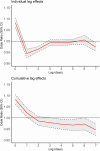Association between wet-bulb globe temperature and epilepsy: a space-time-stratified case-crossover study in Taiwan
- PMID: 40394709
- PMCID: PMC12090581
- DOI: 10.1186/s41182-025-00755-z
Association between wet-bulb globe temperature and epilepsy: a space-time-stratified case-crossover study in Taiwan
Abstract
Background: Epilepsy is a common neurological disorder characterized by an enduring predisposition to generate epileptic seizures, along with its neurobiological, cognitive, psychological, and social consequences. Although a few studies have assessed the associations of meteorological factors, such as temperature, atmospheric pressure, and relative humidity, with epilepsy, their findings remain inconsistent. In this study, we used the wet-bulb globe temperature (WBGT), an integrated heat stress index closely aligned with human thermal perception, to assess its associations with epilepsy risk.
Methods: This study employed a space-time-stratified case-crossover study design, analyzing 187,657 epileptic seizures recorded in emergency department visits in the Taiwan Health Insurance Research Database between 2007 and 2017. Daily WBGT values at individuals' residential addresses were estimated using a 1-km resolution spatiotemporal model. The effects of an interquartile range (IQR) increase in WBGT on the day of epileptic seizures were compared to 3-4 reference days within the same month using conditional logistic regressions combined with distributed lag non-linear models (DLNMs).
Results: The lag-response relationship indicated a significant positive association between WBGT and epilepsy risk at lag 0 day (odds ratio [OR] = 1.083, 95% confidence interval [CI]: 1.061-1.105), whereas significant negative associations were observed at lag 1 and lag 2 day, suggesting a harvesting effect. The cumulative effect of heat persisted for 2 days. Additionally, the exposure-response relationship between WBGT and epilepsy at lag 0 day was linear, with no apparent threshold observed.
Conclusion: Our findings suggest that heat exposure may trigger epilepsy, resulting in short-term clustering of epilepsy cases. As precision medicine continues to gain prominence, incorporating precise heat stress indicator, such as WBGT, into individualized epilepsy management strategies may enhance patient care and seizure prevention.
Keywords: Climate change; Epilepsy; Space–time-stratified case-crossover study; Wet-bulb globe temperature.
© 2025. The Author(s).
Conflict of interest statement
Declarations. Ethics approval and consent to participate: The study was approved by the Institutional Review Board of the China Medical University Hospital (CRREC-110-020) and complied with the principles outlined in the Helsinki Declaration. Consent for publication: Not applicable. Competing interests: The authors declare no competing interests.
Figures



Similar articles
-
Heat Stress and Placental Abruption: A Space-Time Stratified Case-Crossover Study.BJOG. 2025 Apr 10. doi: 10.1111/1471-0528.18163. Online ahead of print. BJOG. 2025. PMID: 40207567
-
Heat stress morbidity among US military personnel: Daily exposure and lagged response (1998-2019).Int J Biometeorol. 2022 Jun;66(6):1199-1208. doi: 10.1007/s00484-022-02269-3. Epub 2022 Mar 15. Int J Biometeorol. 2022. PMID: 35292853
-
Evaluating long-term and high spatiotemporal resolution of wet-bulb globe temperature through land-use based machine learning model.J Expo Sci Environ Epidemiol. 2024 Nov;34(6):941-951. doi: 10.1038/s41370-023-00630-1. Epub 2023 Dec 16. J Expo Sci Environ Epidemiol. 2024. PMID: 38104232
-
Association between wet-bulb globe temperature with peptic ulcer disease in different geographic regions in a large Taiwanese population study.BMC Gastroenterol. 2025 Apr 2;25(1):216. doi: 10.1186/s12876-025-03803-4. BMC Gastroenterol. 2025. PMID: 40175940 Free PMC article.
-
Is Physiological Equivalent Temperature (PET) a superior screening tool for heat stress risk than Wet-Bulb Globe Temperature (WBGT) index? Eight years of data from the Gothenburg half marathon.Br J Sports Med. 2021 Aug;55(15):825-830. doi: 10.1136/bjsports-2019-100632. Epub 2020 May 28. Br J Sports Med. 2021. PMID: 32467149
References
-
- Ebi KL, Hess JJ. Health risks due to climate change: Inequity in causes and consequences. Health Aff. 2020;39:2056–62. - PubMed
-
- Gulcebi MI, Bartolini E, Lee O, Lisgaras CP, Onat F, Mifsud J, Striano P, Vezzani A, Hildebrand MS, Jimenez-Jimenez D, Junck L, Lewis-Smith D, Scheffer IE, Thijs RD, Zuberi SM, Blenkinsop S, Fowler HJ, Sisodiya SM, Foley A, Epilepsy Climate Change Consortium, Sisodiya SM. Climate change and epilepsy: insights from clinical and basic science studies. Epilepsy Behav. 2021;116:107791. - PMC - PubMed
-
- Fisher RS, Acevedo C, Arzimanoglou A, Bogacz A, Cross JH, Elger CE, EngelForsgren JL, French JA, Glynn M, Hesdorffer DC, Lee BI, Mathern GW, Moshé SL, Perucca E, Scheffer IE, Tomson T, Watanabe M, Wiebe S. ILAE official report: a practical clinical definition of epilepsy. Epilepsia. 2014;55:475–82. 10.1111/epi.12550. - PubMed
-
- Motta E, Gołba A, Bal A, Kazibutowska Z, Strzała-Orzeł M. Seizure frequency and bioelectric brain activity in epileptic patients in stable and unstable atmospheric pressure and temperature in different seasons of the year–a preliminary report. Neurol Neurochir Pol. 2011;45:561–6. - PubMed
Grants and funding
LinkOut - more resources
Full Text Sources
Research Materials
